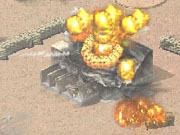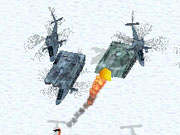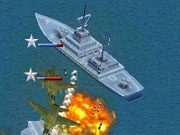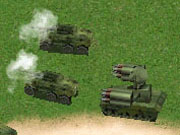Real War is a throwback to the days of those horrible real-time strategy clones that followed the success of Westwood's Command & Conquer series. Like most of the games that tried to ride Westwood's coattails, this is an example of amateurish game design at its worst. And considering its subject matter--the US military going abroad to battle terrorists--it's also an example of colossally bad timing.

Real War is entirely conventional in many ways. It's a typical real-time strategy game featuring modern weaponry rather than fictitious sci-fi or fantasy armaments. The two sides are the US military and the generically named terrorist organization, the Independent Liberation Army (which begs the question, "If they're independent, from whom do they want to be liberated?"). You can choose the single-player campaign of 12 linear missions or a skirmish game. The campaign missions tend to have specific objectives, while the skirmish games are last-man-standing slugfests to the finish. You start with a headquarters and then build land, air, and sea command centers to unlock the basic units. You can upgrade your buildings to unlock new units. Power generators give you the energy your buildings need to function, and supply depots give you the resources you need to build units. Near the end of the build tree, you'll find weapons of nuclear, biological, and psychological warfare.
There are a few interesting angles Real War takes from the traditional real-time strategy conventions. There's a limit to the number of each type of unit and structure you can build. This puts a limit on the size of your army and how much you can expand across the map. It also forces you to use a combined-arms approach, since you can't focus solely on one type of unit. Instead of harvesting resources like gold or ore, your "supply" is automatically generated when you build supply depots. For each depot, a helicopter periodically flies in from the map edge and unloads "supply" into your reserves, which can then be used for building units and structures. Theoretically, you have to protect your helicopters from enemy attack, but they're invulnerable if you simply build your depots against the map edge. However, because the number of depots you can build is limited, Real War minimizes economic micromanagement and lets you focus on your military units.
And you'll definitely need to focus on your military units, because Real War's interface, artwork, and unit AI are an utter nightmare. Useful hotkeys are AWOL. There is no speed adjustment, and the game moves so quickly that your army can quickly scurry out of control. The basic idea behind the interface is admirable; at the bottom of the screen, there's a button for every unit and building. This means you won't have to scroll around the map to find something. But the buttons are tiny pictures about 25 pixels wide crammed into a small box. They're hard enough to make out because they're so small, but even the artwork is indistinguishable; there are vague drawings of trucks, buildings, lumpy colors, and other less-than-helpful stuff that doesn't look like anything on the map. Topware Interactive's 3D real-time strategy game Earth 2150 took a similar approach with more success because the buttons were bigger and they used the same 3D models from the game engine.

Many of Real War's units are virtually impossible to distinguish, especially when they're selected and a thick cloud of health bars and experience icons obscures them. Vehicles tend to be the boxy generic equivalents of plastic army-men toys. Even at the tightest zoom, infantry units are little more than dots. Many of the ship models look similar. Only aircraft fare well in this game because they're modeled after distinct real-world airframes. The engine is strictly 2D, but the animation allows units to move as if they were polygonal: They're not fixed to specific directions, and they can even turn over or fly through the air when they explode. But when traveling, they slide across the terrain as if they were skidding on ice, often moving at weird angles. It's odd to see an aircraft carrier moving sideways, but this is what happens in Real War when it's trying to scoot out of the way of another unit.
However, units more often shuffle over and through each other, clustering themselves into chaotic blobs. There are formations in the game, but they don't have any significant effect. Neither do the orders for units to launch simultaneous attacks. For some reason, Real War's putative formations aren't even included in multiplayer games. This certainly isn't because the CPU is working overtime on unit AI. These are some of the most helpless units you'll ever have the displeasure of herding. Real War features pathfinding that's incapable of going around a forest, much less navigating a gap in a defensive wall.

If Real War had worked better, the unit variety and build tree might have been interesting. Units like destroyers and subs can build a store of long-range cruise missiles. Carriers can build their own custom squadrons. Aircraft can be defended with flares and jamming equipment to shut down antiair weapons. Satellites can be positioned over parts of the map to keep a constant line of sight. Planes drop leaflets onto enemy units to demoralize them. The terrorists can use transport vehicles for suicide missions. There's the basis for a decent game here, but it seems the developers weren't quite up to the task.
However, Real War isn't just a bad game. It's also an exercise in horrible timing. It was released exactly two weeks after the September 11th attacks. It includes language in the terrorist campaign about causing the loss of American lives and hitting civilian targets. There are rendered cutscenes of burning cities. The US campaign ends with a view of the Pentagon, minus the dark gash cut into its west side. If ever there was a candidate for being retooled in light of recent events, it was Real War. And if there's any subject matter that's currently inappropriate for this sort of frivolous treatment, it's a war conducted against terrorists overseas. This isn't to accuse the game of poor taste so much as fortuitous timing. But if Westwood had the presence of mind to alter the artwork on Red Alert 2's boxes, Simon & Schuster looks insensitive in comparison when it lets Real War wend its way to retail shelves in its current state.

The developer, Rival Interactive, created the game as a commercial version of Joint Force Employment, a "multimedia CD-ROM" it's been trying to sell to the military. Because Real War was based on a training tool that some poor slob in the military might have been duped into requisitioning, you'll find claims of "realism" and "authenticity" stuck all over Real War. "Based On The Official Joint Chiefs Of Staff Training Game Developed For The U.S. Military," the front of the box reads. But this game's very name is patently absurd. There's minimal realism in the design, much less in the execution. Even if the tanks weren't stupidly driving around like drunken bumper cars, they wouldn't be engaging each other at these ranges. A tactical nuke will destroy more than a single building. Submarines don't launch cruise missiles a stone's throw from the shore. And it's not just the scale that's hopelessly fudged. Infantry don't stand out in the open and wait for vehicles to squash them. Propaganda leaflets dropped on an army don't cause them to run away. Helicopters and jet aircraft don't fly in formation with each other. Red Alert 2 has just as much claim to authenticity as Real War. By boasting that they've included authentic military units and realistic tactics, Rival Interactive and Simon & Schuster are insulting not only their audience, but their subject matter as well.
One of the saddest things about this Johnny-come-lately to the real-time scene is that actor R. Lee Ermey was hired to do the voice-over for the US campaign. By his voice, you'll instantly recognize Ermey as the ill-fated drill sergeant in Full Metal Jacket or the commander of the plastic army men in the Toy Story movies. Ermey's voice is full of force and personality, but they have him narrate Real War's campaign with the steady insistent drumbeat of a drill sergeant. As each mission loads, he barks embarrassing slogans like, "Semper fi, do or die, gung ho, gung ho, gung ho!" Has he fallen so far that it's come to this? At least when you exit Real War, he barks, "Oh boy, oh boy, isn't that sweet? You're givin' up!" Thank you, R. Lee Ermey, for making it that much more enjoyable to exit Real War.